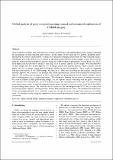Files in this item
Global analysis of gully composition using manual and automated exploration of CRISM imagery
Item metadata
| dc.contributor.author | Allender, Elyse | |
| dc.contributor.author | Stepinksi, Tomasz F. | |
| dc.date.accessioned | 2019-11-29T00:36:52Z | |
| dc.date.available | 2019-11-29T00:36:52Z | |
| dc.date.issued | 2018-03-01 | |
| dc.identifier | 251713044 | |
| dc.identifier | 7c1746f0-7316-4970-aa65-f39985205e8a | |
| dc.identifier | 85035333490 | |
| dc.identifier | 000423779600024 | |
| dc.identifier.citation | Allender , E & Stepinksi , T F 2018 , ' Global analysis of gully composition using manual and automated exploration of CRISM imagery ' , Icarus , vol. 302 , pp. 319-329 . https://doi.org/10.1016/j.icarus.2017.11.017 | en |
| dc.identifier.issn | 0019-1035 | |
| dc.identifier.other | ORCID: /0000-0002-0052-7895/work/64698161 | |
| dc.identifier.uri | https://hdl.handle.net/10023/19021 | |
| dc.description | This work was supported by the University of Cincinnati Space Exploration Institute. | en |
| dc.description.abstract | Gully formations on Mars have been the focus of many morphological and mineralogical studies aimed at inferring the mechanisms of their formation and evolution. In this paper we have analyzed 354 globally distributed gully-bearing Full Resolution Targeted (FRT) Compact Reconnaissance Imaging Spectrometer for Mars (CRISM) images. The primary goal of the analysis was to identify all spectrally distinct deposits in these images (if any) and to classify them into hydrated and non-hydrated categories using only CRISM summary parameters (Viviano-Beck et al., 2014). Such an approach makes it possible to analyze a very large set of all distinct deposits in 354 images. We found that 68% of these images lack any distinct deposits, 8% of images contain non-hydrated deposits which coincide with the gullies and 24% of images contain hydrated deposits which coincide with the gullies. These results are compared with the recent analysis of 110 CRISM images by Nuñez et al. (2016) who also found that most gullies coincide with indistinct deposits, but, contrary to our findings, they found a predominance of non-hydrated minerals among distinct deposits. We attribute this discrepancy in part to their smaller and geographically biased sample of images, and in part to differing protocols of categorizing images. The discrepancy between the two surveys is further increased if we count all deposits in FRT gully-bearing images, not just deposits directly coinciding with the gullies, obtaining 44% indistinct, 15% non-hydrated, and 41% hydrated images. The secondary goal of this study was to perform the same image survey using a recently developed automated method in order to assess its accuracy and thus its feasibility for performing future surveys. We found the overall accuracy of the auto-mapper to be 76.2% but its accuracy for discovering distinct deposits, and in particular, distinct hydrated deposits was lower. We attributed the deficiencies of the auto-mapper primarily to its sensitivity to presence of noise in images and especially to presence of speckle noise. It is however worth noting that qualitatively both manual and automatic surveys arrived at the same overall conclusion. | |
| dc.format.extent | 10 | |
| dc.format.extent | 20758091 | |
| dc.language.iso | eng | |
| dc.relation.ispartof | Icarus | en |
| dc.subject | Mars | en |
| dc.subject | CRISM | en |
| dc.subject | Gullies formation | en |
| dc.subject | Mineral composition | en |
| dc.subject | Automatic analysis | en |
| dc.subject | GE Environmental Sciences | en |
| dc.subject | QB Astronomy | en |
| dc.subject | NDAS | en |
| dc.subject.lcc | GE | en |
| dc.subject.lcc | QB | en |
| dc.title | Global analysis of gully composition using manual and automated exploration of CRISM imagery | en |
| dc.type | Journal article | en |
| dc.contributor.institution | University of St Andrews. School of Earth & Environmental Sciences | en |
| dc.identifier.doi | https://doi.org/10.1016/j.icarus.2017.11.017 | |
| dc.description.status | Peer reviewed | en |
| dc.date.embargoedUntil | 2018-11-22 |
This item appears in the following Collection(s)
Items in the St Andrews Research Repository are protected by copyright, with all rights reserved, unless otherwise indicated.

